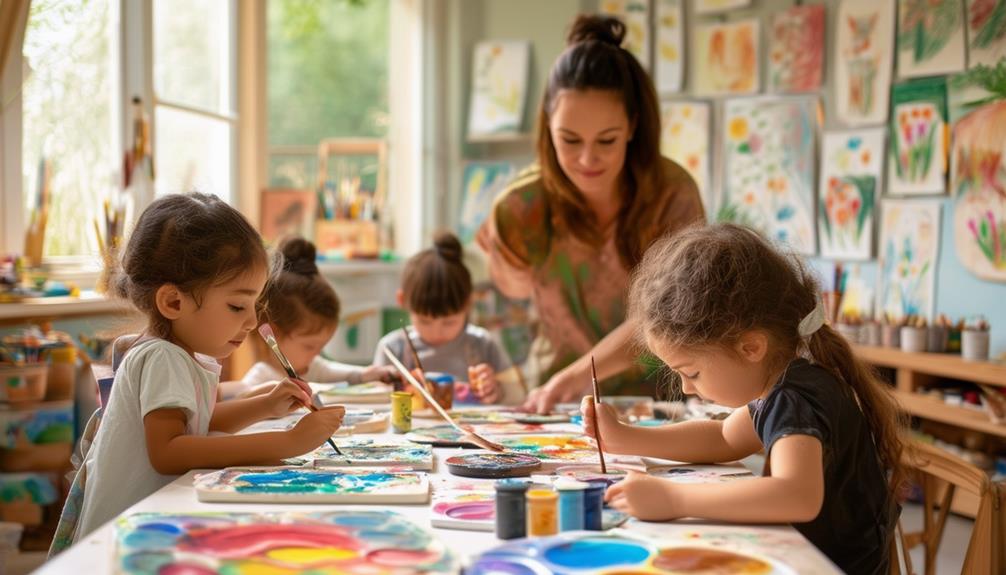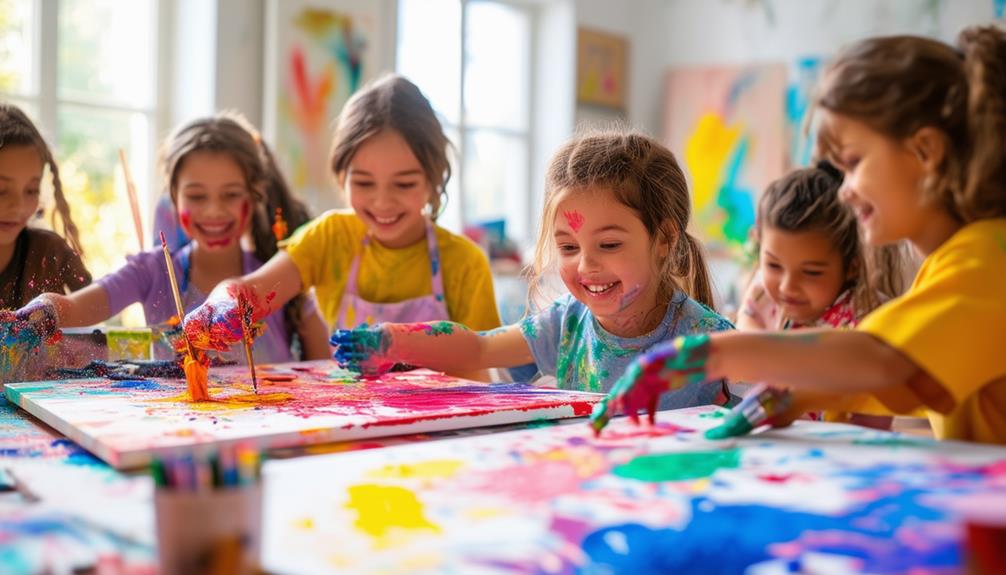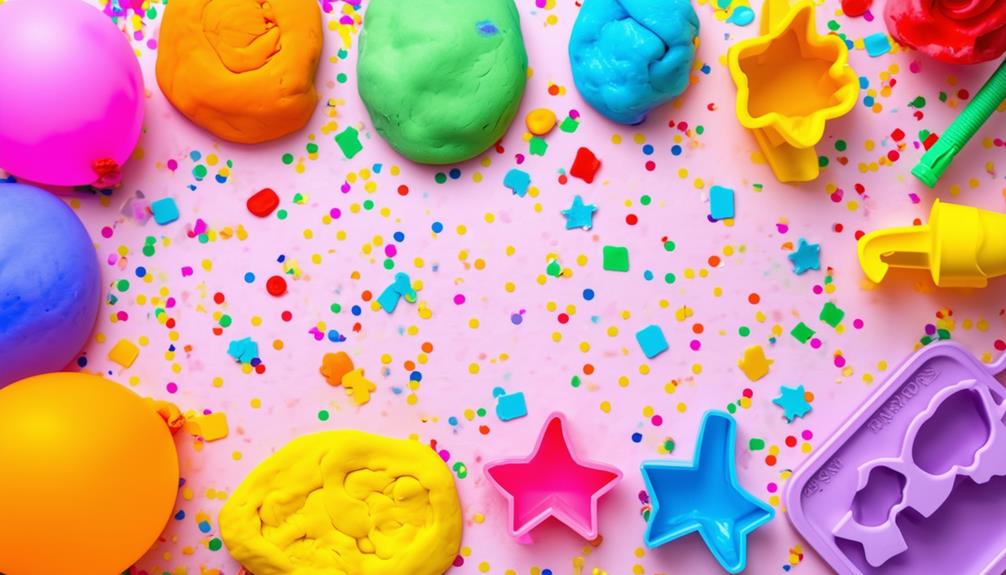Playdough Learning Activities for Preschoolers
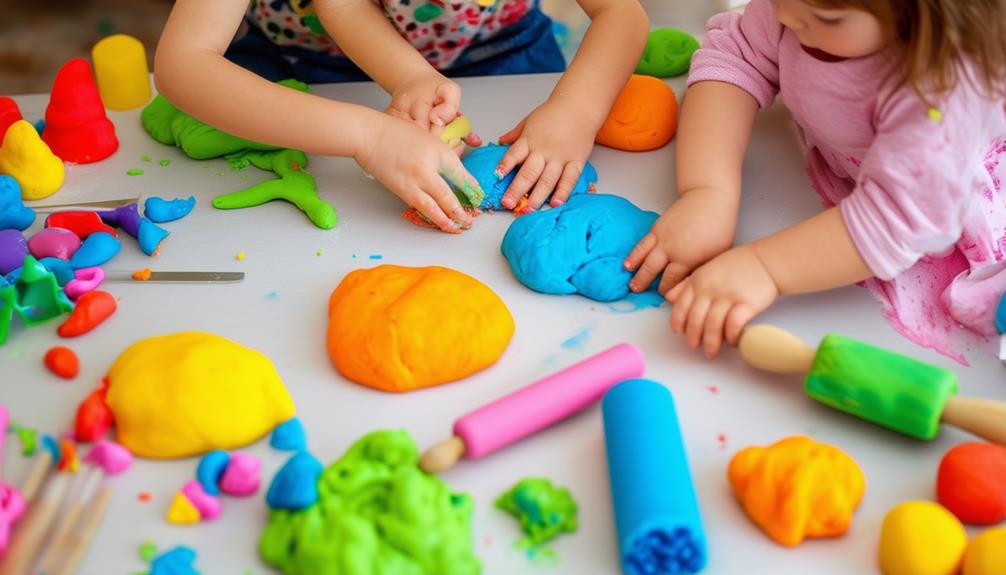
Playdough learning activities can significantly enhance your preschoolers' educational experience. By engaging in these hands-on tasks, children can improve their fine motor skills, creativity, and even basic math concepts seamlessly. Imagine your child creating colorful rainbow snakes or running a playdough pizza parlor. These activities do more than entertain—they lay the foundation for cognitive development and social interaction. What materials do you need, and how can you seamlessly incorporate these activities into your daily routine? Let's explore how you can get started and make playdough an integral part of your educational toolkit.
Educational Benefits
Engaging preschoolers in playdough activities significantly enhances their fine motor skills, creativity, language development, and basic math understanding. Manipulating playdough strengthens small hand muscles and improves hand-eye coordination, essential for tasks like writing and buttoning clothes. Rolling, squeezing, and shaping the material aid in developing these critical skills.
Playdough also ignites creativity and imagination. Children express themselves artistically by creating shapes, animals, or pretend foods, fostering problem-solving abilities. For instance, if a child's sculpture collapses, they learn to think of ways to make it stable.
Furthermore, playdough promotes language development. When kids play together, they discuss their creations, describe textures, and share ideas, enhancing their vocabulary and communication skills. They naturally incorporate new terms and form more complex sentences.
Additionally, playdough introduces basic math concepts. Activities like counting playdough balls, measuring lengths, and comparing sizes build foundational math skills in an engaging, hands-on manner. Incorporating playdough into your child's routine nurtures multiple educational aspects, making learning enjoyable and interactive. You'll observe significant growth in their developmental skills through play.
Essential Materials
To begin with playdough activities, you'll need some essential materials such as playdough, cutting tools, and various props to stimulate imaginative play. These items not only make the activity enjoyable but also enhance fine motor skills, creativity, and sensory exploration in preschoolers.
First, acquire playdough, whether store-bought or homemade. This pliable material is ideal for open-ended play, allowing children to mold and shape it freely. Cutting and shaping tools are crucial as well. These tools help children develop their fine motor skills by enabling them to cut, roll, and press the playdough into different shapes.
Incorporating natural objects and household items into playdough activities can ignite creativity and broaden imaginative play possibilities. Items like leaves, sticks, and buttons can be pressed into the playdough to add texture and design.
Here are some materials you can gather:
- Playdough: Store-bought or homemade
- Cutting tools: Plastic knives, cookie cutters, or rolling pins
- Household items: Buttons, pasta, or bottle caps
- Natural objects: Leaves, sticks, or small stones
Pizza Parlour Activity
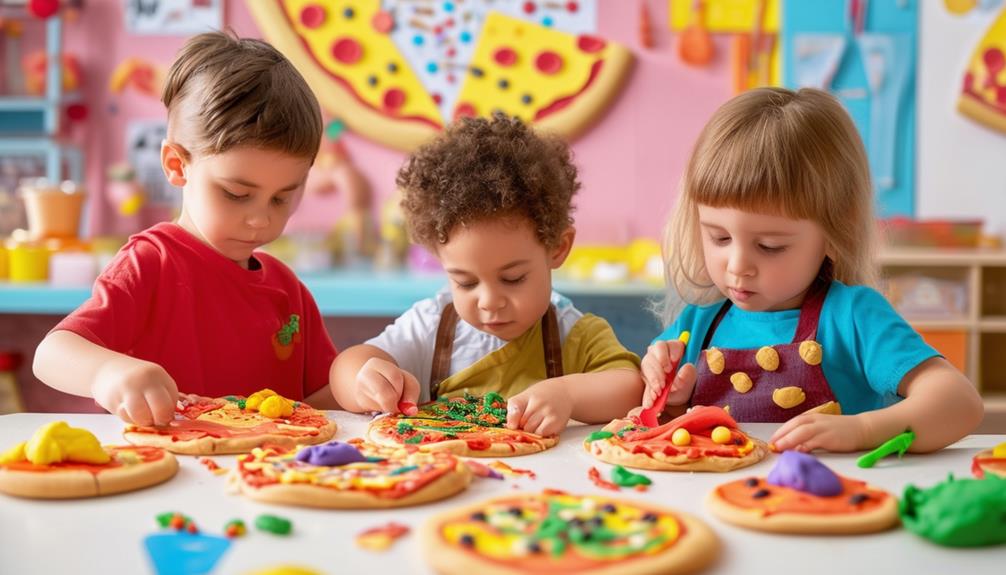
Imagine the excitement on your preschooler's face when they get to run their own playdough pizza parlor! This engaging activity blends learning with fun, making it a perfect choice for young children. By using playdough to create various pizza toppings, your child will develop crucial fine motor skills. Kneading, rolling, and shaping the playdough into different toppings like pepperoni, mushrooms, and cheese can significantly improve their dexterity.
Moreover, this activity supports cognitive development through hands-on learning experiences. Your child will practice reading, counting, and understanding quantities as they create their playdough pizzas. For instance, they can count how many toppings to add or read simple recipe cards you provide. These learning activities make abstract math concepts tangible and easy to grasp.
Role-playing as chefs in a pizza parlor also enhances creativity and social skills. Your preschooler can take orders, 'bake' the pizzas, and serve them to family members or other children. This imaginative play encourages them to think creatively while practicing communication and cooperation skills. The Pizza Parlor activity is a delightful way to combine playdough fun with valuable educational benefits for your preschooler.
Rainbow Snakes Craft
Creating Rainbow Snakes with playdough offers a fun and colorful way for preschoolers to improve their color recognition and scissor skills. Begin by providing a variety of playdough colors. Encourage the children to roll and shape the playdough into long, thin snakes, allowing their creativity to shine.
Once the snakes are formed, guide the preschoolers to carefully cut the playdough snakes into smaller segments. This activity not only enhances their fine motor skills but also helps them understand the importance of precision and control while using scissors.
As they work on their Rainbow Snakes, they'll naturally begin to recognize and differentiate between colors, an essential skill at this developmental stage. You can even turn it into a game by asking them to create snakes of specific colors or patterns.
Benefits of this activity:
- Fine motor skills development: Rolling and cutting playdough improves hand-eye coordination.
- Color recognition: Identifying and using different colors fosters visual learning.
- Scissor skills: Safe, supervised practice with scissors builds confidence.
- Creativity: Designing unique snakes encourages imaginative thinking.
Enjoy watching your preschoolers learn and grow with this delightful and educational playdough activity!
Spiky Hedgehogs Fun
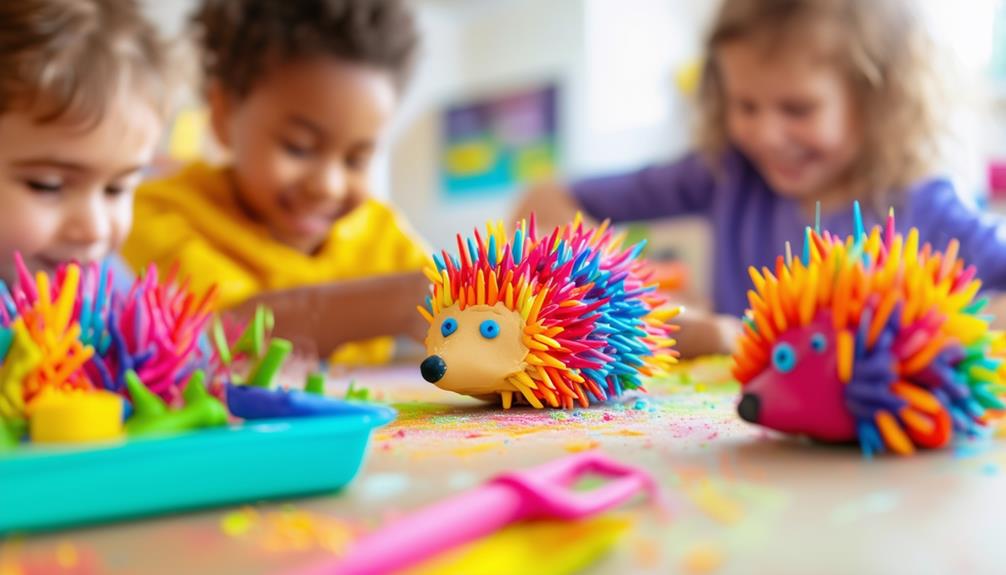
Your preschoolers will love making Spiky Hedgehogs by pressing toothpicks or craft sticks into playdough balls. This fun activity not only engages children but also helps improve their fine motor skills and pincer grasp. Through careful placement of the spikes, kids practice precise movements, crucial for developing fine motor control and hand-eye coordination.
The activity encourages sensory exploration as children manipulate the soft playdough and rigid toothpicks or craft sticks. This tactile experience is stimulating and helps them understand different textures and resistance levels. As they create their spiky hedgehogs, their imagination and creativity flourish.
Add an educational twist by incorporating a sorting activity. Have the preschoolers count and arrange different numbers of spikes on their hedgehogs, reinforcing counting skills and the concept of sorting by quantity. Challenge them further by asking them to sort spikes by length or color, adding another layer of cognitive development.
Teddy Bears Picnic
Organize a Teddy Bears Picnic with playdough to enhance your preschooler's fine motor skills and creativity. This engaging activity stimulates imagination and helps develop small hand muscles. By crafting a picnic scene, your child will engage in pretend play, boosting their social skills and early learning.
To begin, gather playdough in various colors and invite your preschooler to shape food items, picnic blankets, and tiny teddy bears. This activity promotes interactive play and provides an excellent opportunity to practice counting, sorting, and storytelling.
Here are some ways to make your Teddy Bears Picnic even more captivating:
- Craft a Menu: Have your child roll and cut playdough to make sandwiches, fruits, and desserts.
- Set the Scene: Shape a playdough picnic blanket and arrange the food items on top.
- Invite Guests: Use small teddy bears or other toys as guests and involve them in the picnic.
- Interactive Play: Encourage your child to narrate a story about the teddy bears' picnic adventures.
This Teddy Bears Picnic playdough activity not only fosters creativity but also reinforces fine motor skills, making it an excellent choice for early childhood development.
Pirate Treasure Hunt
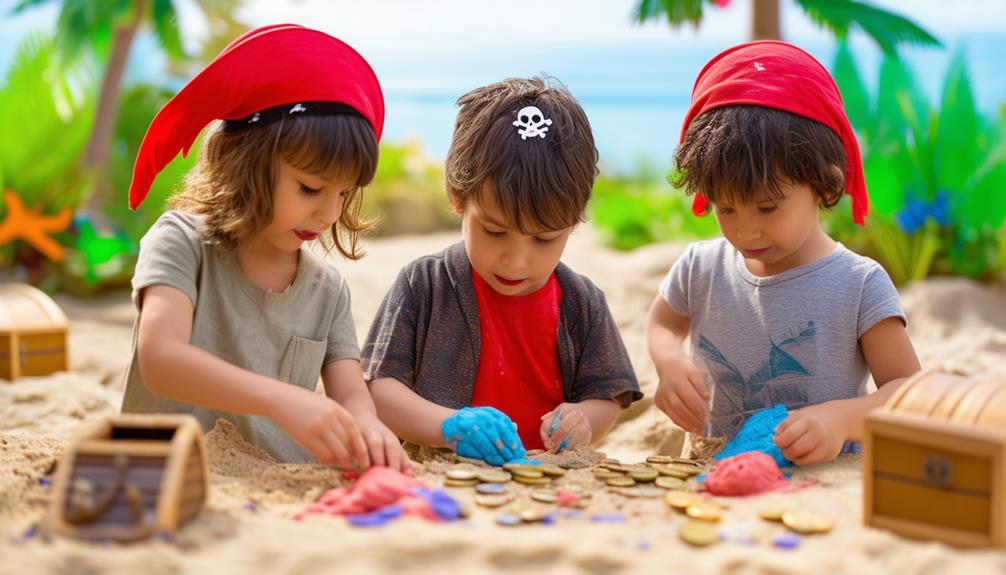
Embark on a thrilling Pirate Treasure Hunt with playdough to spark your preschooler's imagination and problem-solving skills. This engaging activity encourages children to become daring pirates on a quest for hidden riches. Start by concealing small objects, such as beads or coins, within the playdough. Your child can then dig, shape, and manipulate the playdough to uncover the treasures, enhancing their fine motor skills in the process.
The Pirate Treasure Hunt isn't just an individual activity; it also promotes social interaction. When children collaborate to find the hidden treasures, they develop teamwork and communication skills. They can take turns hiding and discovering the riches, fostering a sense of camaraderie and shared accomplishment.
Problem-solving skills are put to the test as children determine the best methods to sift through the playdough and locate the treasures. Additionally, the activity inspires creativity through storytelling. Your preschooler can create tales of daring high-seas adventures, complete with maps, clues, and pirate lingo. This imaginative play not only entertains but also builds cognitive and linguistic abilities, making the Pirate Treasure Hunt a comprehensive and enriching experience.
Playdough Maze Creation
After the excitement of a Pirate Hunt for riches, channel that adventurous spirit into creating intricate playdough mazes that challenge and fascinate preschoolers. This activity combines fun with crucial developmental skills, making it an ideal follow-up to any treasure hunt.
Start by shaping and molding the playdough into a maze-like structure with twists and turns. Encourage your preschooler to get hands-on, enhancing their fine motor skills as they manipulate the dough. Maze creation allows them to use their creativity to design unique pathways and obstacles.
Navigating the maze is significant. As children follow the pathways with their fingers or small objects, they engage in problem-solving, figuring out how to reach the end without hitting any walls. This also promotes hand-eye coordination, helping them develop spatial awareness as they guide their fingers through the intricate paths.
Here are some tips to make your playdough maze creation activity even more engaging:
- Use different colored playdough to differentiate between pathways and obstacles.
- Incorporate small toys that can move through the maze.
- Set a time challenge to make it more thrilling.
- Encourage storytelling where the maze is part of an adventure.
With these steps, your playdough maze creation can be both informative and enjoyable!

